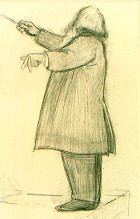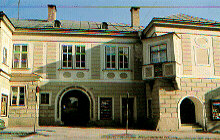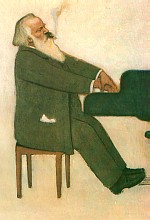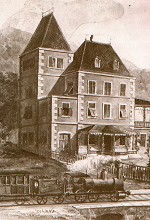The symphonist Brahms
In his work, the years, in which he concerned himself with the form
of the symphony, occupy just one decade. It is true that the first attempts
at the first symphony date from the mid-fifties, but he rejected his composition
drafts again and again. At the end of his life, Brahms destroyed most of
his preparatory works and composition drafts. Therefore it is hardly possible
to duplicate the course of his compositional working process.
Brahms did not feel able to cope with the requirements to compose
a symphony after Beethoven. As he was working on his First Symphony
at the beginning of the seventies, he wrote to the conductor Hermann Levi:
„I will never compose a symphony! You have no idea how the likes of us
feel, when you hear always such a giant marching behind you." In 1876,
already before the completion of the composition, Brahms set a date for
its first performance (November 4th) with the conductor Otto Dessoff from
Karlsruhe. The correspondence of the two friends illuminates Brahms' efforts
to keep the deadline and his iron work on the composition. After breaking
the spell in a way with the First Symphony (C minor, op 68), he composed
the next symphonies in a relatively short time.

Brahms conducting
In June 1877, he started working on the Second (D major, op 73)
in Pörtschach am Wörthersee, in September the first movement
was finished and three months later the whole symphony was finished. On
December 30th, it was performed for the first time in Vienna, Hans Richter
(1843-1916) conducting, the future Viennese court conductor and conductor
of the Bayreuth Festival. He premiered also the Third Symphony in F major
op 90, which was composed six years later during a summer stay in Wiesbaden.
The first performance in a philharmonic concert on December 1883
in Vienna was followed by another performance four weeks later in Berlin,
Joseph Joachim conducting.

The „Brahms house" in Mürzzuschlag
During the summer stays 1884 and 1885 in Mürzzuschlag
on Semmering, Brahms composed his Fourth Symphony (E minor, op 98). On
October
25th 1885, he conducted himself the first performance in Meiningen
with the court orchestra of Meiningen. Since 1881, he had worked
time and again with this excellent orchestra.
Altough Brahms enlarges the classical orchestral instrumentation
in his symphonies just with trombones and the double bassoon and uses occasionally
the bass tuba, he gets an unmistakable orchestral sound: A peculiar warmth
shines out of its more dark colors. The variative technique, that Brahms
developed masterly in several works, had also determined the thematic work
in his symphonic music. The finale of his Fourth Symphony is not without
reason a large-scale succession of variations about an ostinato bass (theme
and thirty coherent variations).
The piano music
Although Brahms scored his first great successes as pianist already at
the age of 15-16, he was not a virtuoso in the current sense of the word.
His forte was not the brilliance and the technical perfection, but the
expressiveness of his play. But he must have been an outstanding pianist,
it is proved by his piano music, which makes highest demands on the interpreter
also in technical respects. The piano music ranks high in Brahms' instrumental
works anyway. A lot of the early compositions are works only for piano:
The trhree sonatas op 1, 2 and 5, the scherzo op 4, the „variations about
a theme by Robert Schumann" op 9 and the ballads op 10.

Johannes Brahms on the grand piano
(Tempera painting by Willy von Beckerath, 1911)
In 1856, he composed the "variations about a Hungarian song"
(op 21 No. 2), in 1857 the „variations about an own theme" (op 21 No. 1),
in 1861 the Händel variations op 24 and in 1862/63 the utmost
virtuoso Paganini variations op 35. Later, Brahms composed exclusively
thematically free piano pieces such as rhapsodies, fantasies and intermezzi.
The solo concerts

The villa Joachim in Aigen near Salzburg
Here, Brahms and Joachim worked together on the violin concerto
The concertos for piano and orchestra are among his most famous works.
The First piano concerto in D minor (op 15) was composed between 1854
and 1857. Brahms used for the composition musical material from
a sonata for two pianos, which is missing today. The version for two pianos
did not satisfy Brahms and he tried first to turn the first movement into
a symphonic movement. Finally, he opted for the rearrangement in a piano
concerto on Clara Schumann's and Joseph Joachim's advice. The first performance
in Hanover in January 1859 scored a considerable success, but the
work was a flop in Leipzig soon after.
Only twenty years later, Brahms set about the composition of his
Second piano concerto in B major (finished in June 1881). With the four
movements and the renunciation of the traditional solo cadenzas he puts
an approach to the symphony into effect - Eduard Hanslick called
the work a „symphony with piano obbligato".
The lieder works
The lyric poetry ranked high in the bourgeois culture of the 19th century
and the poetry set to music, the lied, became the central genre in the
music-making in the homes of the bourgeoisie. Brahms' lieder works span
a period of more than fourty years, beginning with the first published
lieder in Hamburg till the „Vier ernsten Gesängen", that he
finished on his 63rd birthday. He set just a few works of famous poets
to music. He is supposed to have said to the singer Georg Henschel about
Goethe's poems: „They are all so completed you cannot cope with music."
But the less perfect literary works of art by smaller and medium poets
offer to the composer the task to add something to the words by music.
Between those demands on the art song for one thing and the orientation
by the folk song for another, Brahms composed an inexhaustible wealth of
diverse lieder.

Select list of works
|
Titel
|
Opus
|
Composed
|
First performance
|
|
|
|
|
| Orchestral works |
|
|
|
|
|
|
|
| Serenade No. 1, D major |
op 11 |
1857/58 |
Hanover, March 3rd 1860 |
| Piano concerto No. 1, D minor |
op 15 |
1856-57 |
Hanover, January 22nd 1859 |
| Serenade No. 2, A major |
op 16 |
1858/59, 1875 revised |
Hanover, February 1oth 1860 |
| Variations on a theme by J. Haydn, B major |
op 56 a |
1873 |
Vienna, November 2nd 1873 |
| Symphony No. 1, C minor |
op 68 |
1855-76 |
Karlsruhe, November 4th 1876 |
| Symphony No. 2, D major |
op 73 |
1877 |
Vienna, December 30th 1877 |
| Violin concerto, D major |
op 77 |
1878 |
Leipzig, January 1st 1879 |
| Akademische Festouvertüre, C minor |
op 80 |
1880 |
Wroclaw, January 4th 1881 |
| Tragische Ouvertüre, D minor |
op 81 |
1880 |
Vienna, December 26th 1880 |
| Piano concerto No. 2, B major |
op 83 |
1878-81 |
Budapest, November 9th 1881 |
| Symphony No. 3, F major |
op 90 |
1883 |
Vienna, December 2nd 1883 |
| Symphony No. 4, E minor |
op 98 |
1884/85 |
Meiningen, October 25th 1885 |
| Concerto for violin and cello, A minor |
op 102 |
1887 |
Cologne, October 18th 1887 |
|
|
|
|
| Chamber music |
|
|
|
|
|
|
|
| Piano trio No. 1, H major |
op 8 |
1853/54, 1889 revised |
New York, November 27th 1855 |
| Sextet No. 1, B major |
op 18 |
1859/60 |
Hanover, October 20th 1860 |
| Piano quartet No. 1, G minor |
op 25 |
1855-61 |
Hamburg, November 16th 1861 |
| Piano quartet No. 2, A major |
op 26 |
1855-61 |
Vienna, November 29th 1862 |
| Piano quintet, F minor |
op 34 |
1862-64 |
Leipzig, June 22nd 1866 |
| Sextet No. 2, G major |
op 36 |
1864/65 |
Boston, October 11th 1866 |
| Cello sonata No. 1, E minor |
op 38 |
1862-65 |
Leipzig, January 14th 1871 |
| Horn trio, E flat major |
op 40 |
1865 |
Zurich, November 28th 1865 |
| Two string quartets in C minor and A minor |
op 51 |
approx. 1865-73 |
Vienna, December 11th 1873 ( No. 1) |
|
|
|
and Berlin, October 18th 1873 (No. 2) |
| Piano quartet No. 3, C minor |
op 60 |
1855-75 |
Vienna, November 18th 1875 |
| String quartet No. 3 , B major |
op 67 |
1875 |
Berlin, October 30th 1876 |
| Violin sonata No. 1, G major |
op 78 |
1878/79 |
Bonn, November 8th 1879 |
| Piano trio No. 2, C major |
op 87 |
1880-82 |
Frankfurt-on-Main, December 29th 1882 |
| Quintet No. 1, F major |
op 88 |
1882 |
Frankfurt-on-Main, December 29th 1882 |
| Cello sonata No. 2, F major |
op 99 |
1886 |
Vienna, November 24th 1886 |
| Violin sonata No. 2, A major |
op 100 |
1886 |
Vienna, December 2nd 1886 |
| Piano trio No. 3, C minor |
op 101 |
1886 |
Budapest, December 20th 1886 |
| Violin sonata No. 3, D minor |
op 108 |
1886-88 |
Budapest, December 21st 1888 |
| Quintet No. 2, G major |
op 111 |
1890 |
Vienna, November 11th 1890 |
| Clarinet trio, A minor |
op 114 |
1891 |
Berlin, December 12th 1891 |
| Clarinet quintet, H minor |
op 115 |
1891 |
Berlin, December 12th 1891 |
| Two sonatas for clarinet / viola and piano, E flat major |
op 120 |
1894 |
Vienna, January 11th 1895 (No. 1) and January 8th 1895 (No.
2) |
|
|
|
|
| Piano music |
|
|
|
|
|
|
|
| Sonata No. 1, C major |
op 1 |
1852/53 |
Leipzig, December 17th 1853 |
| Sonate No. 2, F-sharp minor |
op 2 |
1852 |
Vienna, February 2nd 1882 |
| Scherzo, E flat minor |
op 4 |
1851 |
Hanover, June 8th 1853 |
| Sonata No. 3, F minor |
op 5 |
1853 |
Magdeburg, beginning of December 1854 |
| Variations on a theme by R. Schumann, F-sharp minor |
op 9 |
1854 |
Berlin, December 12th 1879 |
| Four ballads, "Edward", |
op 10 |
1854 |
Vienna, March 21st 1860 ( No. 2 and No. 3), November 23rd
1867 ( No. 1 and No. 4) |
| Variations and fugue on a theme by G.F. Händel, B major |
op 24 |
1861 |
Hamburg, December 7th 1861 |
| Variations on a theme by Paganini, A minor |
op 35 |
1862/63 |
Zurich,November 25th 1865 |
| 16 waltzes |
op 39 |
1865 |
Hamburg, November 15th 1868 |
| Eight piano pieces |
op 76 |
1878 |
Berlin, October 29th 1879 |
| Two rhapsodies, H minor, G minor |
op 79 |
1879 |
Krefeld, January 20th 1880 |
| Seven fantasies |
op 116 |
1892 |
Vienna, January 30th 1893 ( No. 1-3) and February 18th 1893
( No. 7), London, March 15th 1893 ( No. 6) |
| Three intermezzi, E flat minor, B minor, C sharp minor |
op 117 |
1892 |
London, January 30th 1893 ( No. 1 and 2) and Hamburg, November
27th 1893 ( No. 3) |
| Six piano pieces |
op 118 |
? 1893 |
London, January 22nd 1894 ( No. 3 and 5) and March 7th 1894
( No. 1-6) |
|
|
|
|
| For two pianos |
|
|
|
|
|
|
|
| Sonata, F minor |
op 34 b |
1864 |
Vienna, April 17th 1864 |
| Variations on a theme by J. Haydn, B major |
op 56 b |
1873 |
Vienna, February 10th 1874 |
|
|
|
|
| Works for organ |
|
|
|
|
|
|
|
| Eleven choral preludes |
op 122 |
1896 |
Berlin, April 24th 1902 |
|
|
|
|
| Vocal and choral works |
|
|
|
|
|
|
|
| Love songs, 18 waltzes |
op 52 |
1868/69 |
Vienna, January 5th 1870 |
| New love songs, 15 waltzes |
op 65 |
1874 |
Karlsruhe, May 8th 1875 |
| Gypsy songs |
op 103 |
1887/88 |
Berlin, October 31st 1888 |
| Ave Maria |
op 12 |
1858 |
Hamburg, December 2nd 1859 |
| Begräbnisgesang |
op 13 |
1858 |
Hamburg, December 2nd 1859 |
| Psalm 13 |
op 27 |
1859 |
Hamburg, September 19th 1859 |
| A German requiem |
op 45 |
1854-68 |
Bremen, April 10th 1868 ( No. 1-7) |
| Rinaldo, Cantata |
op 50 |
1863-68 |
Vienna, February 28th 1869 |
| Rhapsody, A major |
op 53 |
1869 |
Jena, March 3rd 1870 |
| Schicksalslied |
op 54 |
1868-71 |
Karlsruhe, October 18th 1871 |
| Triumphlied |
op 55 |
1870/71 |
Karlsruhe, June 5th 1872 |
| Nänie |
op 82 |
1880/81 |
Zurich, December 6th 1881 |
| Gesang der Parzen |
op 89 |
1882 |
Basel, December 10th 1882 |
| Sieben Marienlieder |
op 22 |
1859 |
Munich, December 1st 1873 |
| Two motets |
op 29 |
? 1860 |
Vienna, April 17th 1867 |
 |